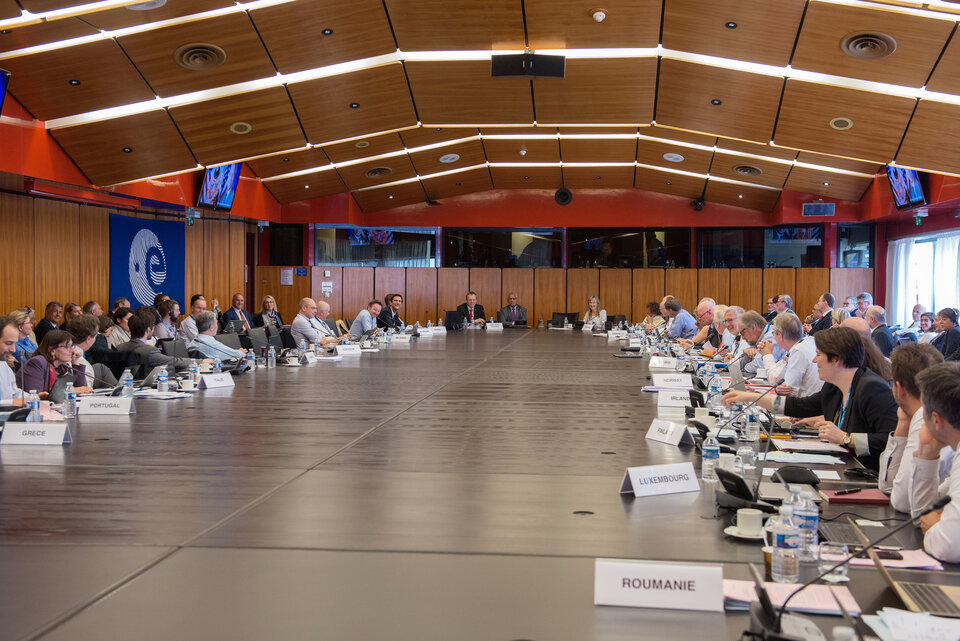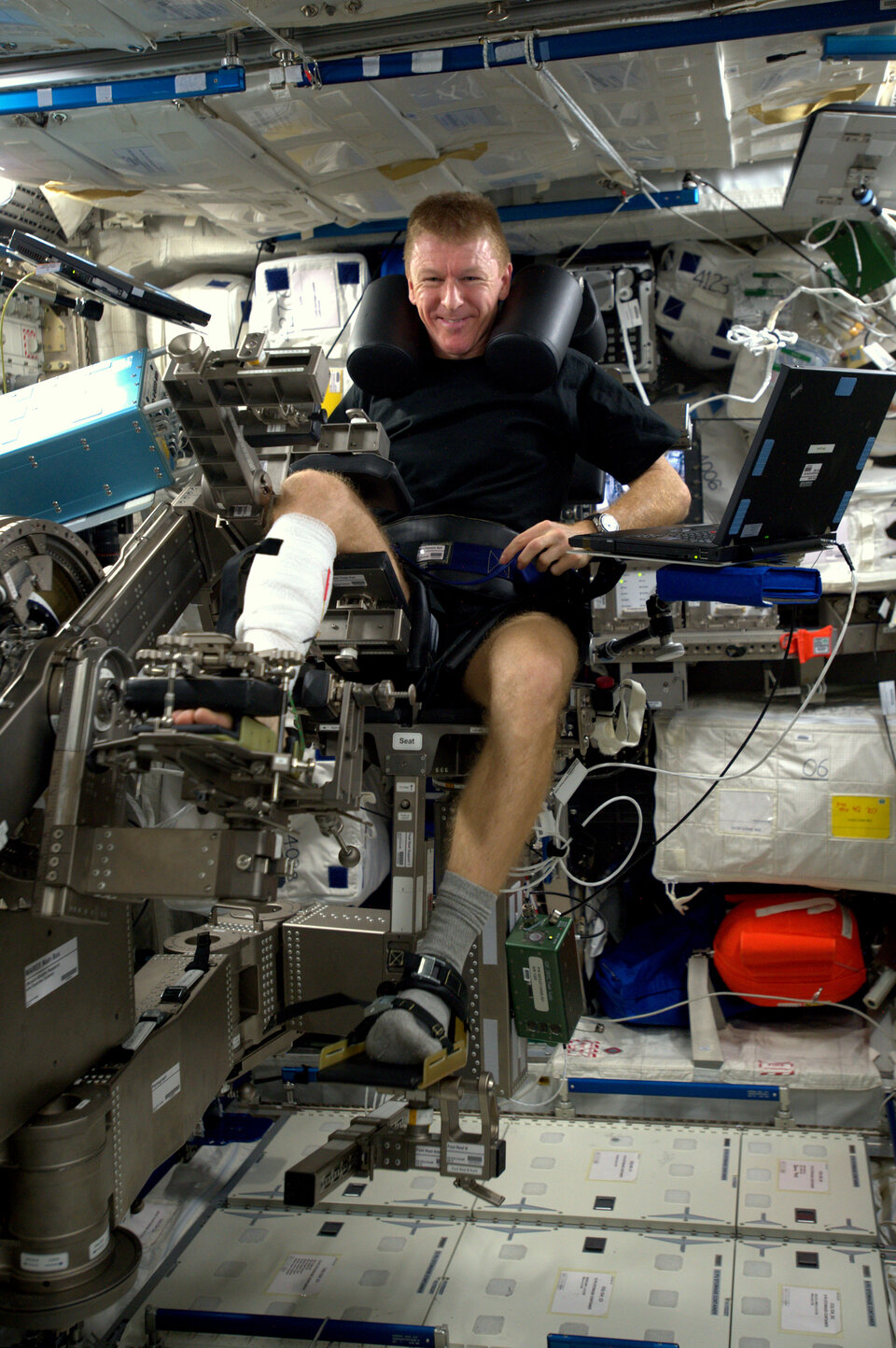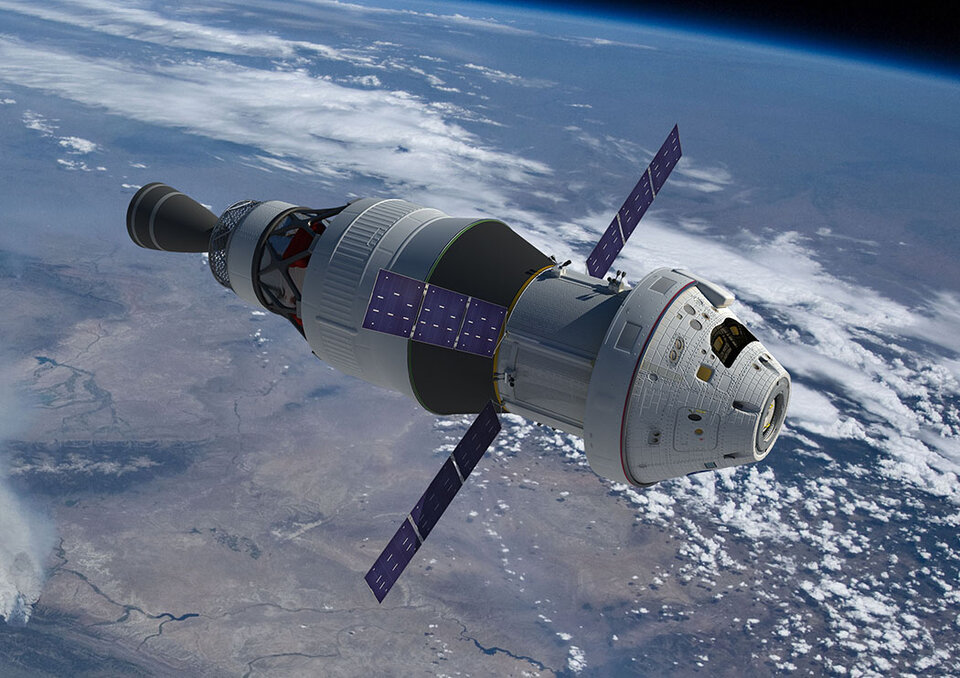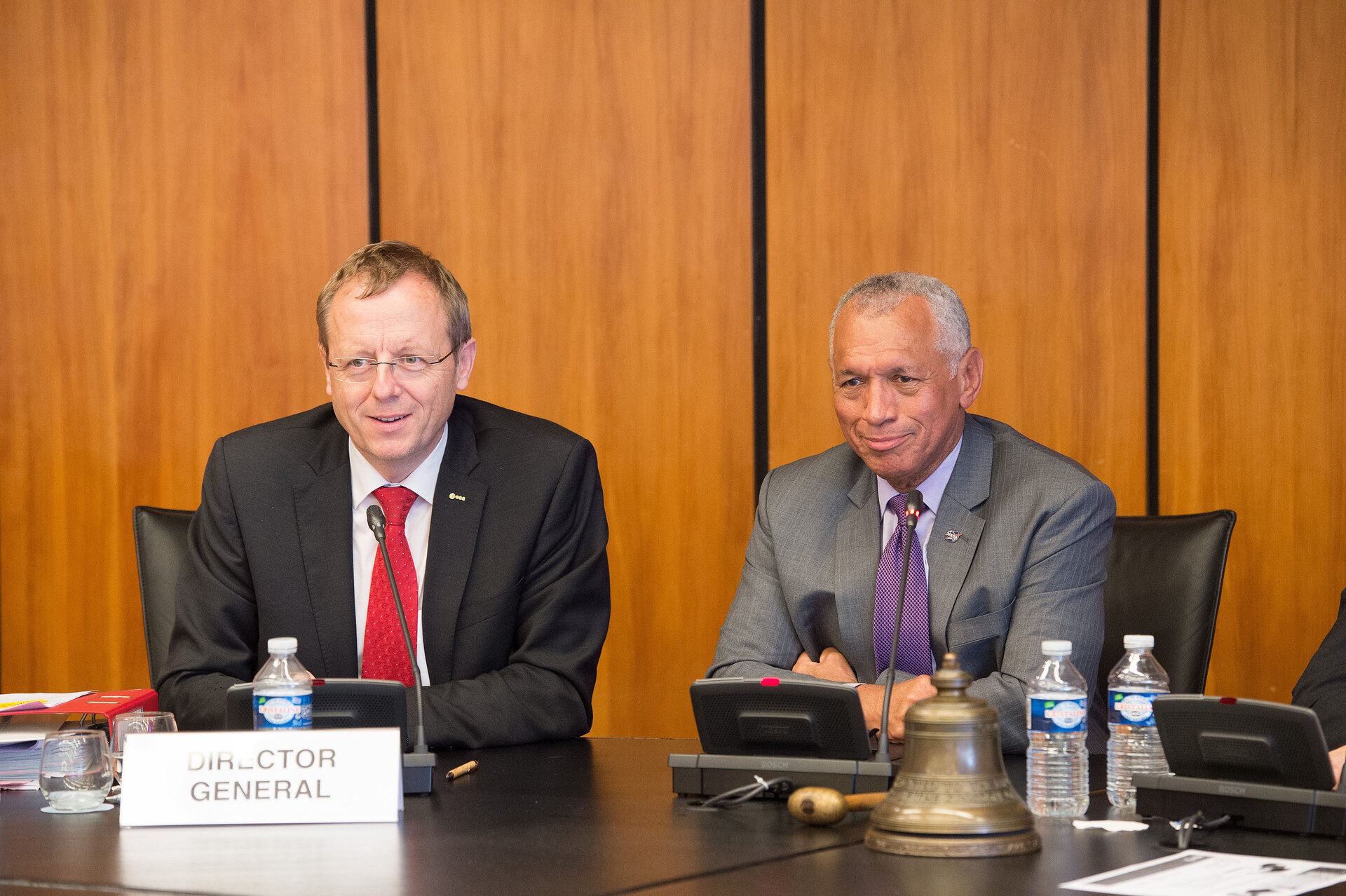NASA Administrator Bolden at ESA Council
NASA Administrator Charles F. Bolden Jr addressed the ESA Council yesterday at the end of the session. This was an opportunity for him to share with Council Delegates information about NASA’s priorities, future direction and touch upon matters relevant to the ESA Council meeting at ministerial level in December, in particular NASA’s expectation that ESA will be able to commit to the extension of the International Space Station until 2024, as all other partner agencies have already done. Read the full transcript.
Address to ESA Council by Administrator, Paris 15 June 2016
Dear Professor Wörner, co-chairs Bo Andersen and Jean-Yves Le Gall; delegation heads; distinguished friends and colleagues, it is an honor and a privilege to have this unique opportunity to address the ESA Council. I recognize that you are in the midst of intensive consultations, as you prepare for your Ministerial Council in December, so thank you even more so for spending some of your precious time with me today.

ESA and NASA have a long tradition of cooperation spanning decades and nearly all of the disciplines in NASA’s space portfolio. We have been together since ESA’s beginning. We started collaborating in Space Science and Human Spaceflight and expanded our collaboration to include Earth Science and Space Technology. Our partnership is long and strong, stretching from the Hubble Space Telescope to JWST; from LISA Pathfinder and Mars Express.
Together we forged the beginnings of the International Space Station (ISS) and, recently, the Service Module for the Orion spacecraft. From the Columbus module to the flight of countless ESA astronauts, the depth and range of our collaboration are remarkable.
Our scientists, researchers, engineers, astronauts and our leaders know and trust each other and seek each other’s counsel and cooperation. Yet as impressive as our past together has been and as productive as our present is, our future can be even more exciting and I’d like to talk to you today about that future, our future together. Our future starts with the ISS.
From the ISS, we can look out into our solar system and beyond and on our own home, Earth. We can research fundamental physics and study how to keep our bodies healthy. We can even grow lettuce and launch satellites.

The Space Station’s capabilities stretch across disciplines; it truly is at the center of so much of what we, as space agencies and as nations, do to push the boundaries of exploration. The Space Station also has tremendous relevance to us on Earth. The Expedition 34 crew patch carried the phrase “off the Earth, for the Earth”. This phrase captures well one of the unique aspects of ISS research. With crews on board we have assembled a unique biological research suite that rivals the capability of terrestrial laboratories on Earth. We have equipment on ISS that is identical to the equipment in those labs. We also have the ability to study the same model organisms that they study: fish, rodents, plants and fruit flies. But the unique properties of microgravity on biological systems gives researchers new insight into problems that they are studying on Earth – effects like bone loss, muscle wasting, immune system degradation and DNA changes. This research can radically change treatments and approaches to diseases.
Seeing the potential of ISS to help solve terrestrial problems and to support our journey to Mars, in January 2014, the Obama Administration announced its commitment to extend the ISS through at least 2024. Despite tight budgets and competing domestic priorities, Russia, Japan and Canada have all also made the decision to commit to supporting ISS operations through at least 2024. I know that ESA ministers will be considering extending participation in the ISS at the upcoming Ministerial in the midst of competing institutional needs and while dealing with social, political and financial challenges back home. Still, I urge all of you, whether your nation is subscribed to the ISS or not, to advocate with your ministers about the importance of the Space Station for not only our near-term objectives, but also for our long-term future. By committing to extend ISS operations to at least 2024, you will help ensure our ability as a Partnership to maximize the scientific and technical return of our substantial investment.
You will also position us to work together on new space exploration far into the future and support research that can help everyone on Earth.
As many of you are aware, we are pursuing an international human Journey to Mars that involves three important stages. Right now, ESA, NASA and our partners are in stage one: the “Earth Reliant” stage. We can reach the Space Station in less than a day; we have regular cargo missions bringing up supplies and equipment. European industry is helping us with these cargo missions by providing the Cygnus capsule as part of Orbital ATK’s commercial resupply contract. Transitioning the operations costs for low-Earth orbit assets to the private sector will free up resources for us to move into stage two, the “Proving Ground”, where we will learn to conduct complex operations in a deep space environment in the vicinity of the moon that still allows crews to return to Earth in a matter of days.
By providing the European Service Module for our deep space transport vehicle, Orion, ESA is with us in this stage as well.
The third phase is becoming “Earth Independent” by building upon what we are learning on the Space Station and what we will learn in the “Proving Ground” of the lunar vicinity to enable human missions to Mars. It is with this plan in mind that I’m here today to encourage you to continue your support for human exploration, starting with an ESA Council decision this coming December to extend ISS operations to at least 2024, a critical step to continue advancing humanity’s presence farther into the solar system and, ultimately, completion of the Journey to Mars.
ESA and NASA have a long history of relying on each other. With the ISS, ESA is in the critical path of the first stage of our journey – the continuation of ISS to at least 2024. As provider of the Orion service module, ESA is now in the critical path of the second stage.
I hope that the future will see Europe, through ESA, firmly in the critical path of the third stage as well. It is also my hope that we at NASA will be in your critical paths of many of your future missions, as we have been throughout our long relationship.
As we look toward sending astronauts beyond low-Earth orbit with the eventual goal of sending them to Mars, we realize that there are multiple challenges we will need to address related to crew health, life support technologies and entry descent and landing on the Martian surface. These are some of the challenges that we in the ISS Partnership are addressing right now on the Space Station. By extending the Space Station to at least 2024 we, as a Partnership, can continue to conduct the research and technology demonstrations that are critical to moving humans beyond low-Earth orbit.
Throughout the assembly of the Space Station and during more than 15 years of permanent human habitation now, we have tested and advanced our ability to live and work in space. Every day, as a Partnership, we understand better what it means to conduct long-term operations. Our hardware and software systems sometimes break down, but as a Partnership we make repairs and configuration improvements. We learn how to build and maintain components that are more robust.
The Space Station is not only a platform that will enable human exploration of an asteroid and Mars; it is also a world-class microgravity research laboratory. So, we are proud that today we are conducting fundamental and applied research that advances our scientific knowledge of Earth, space, physical and biological sciences aboard the ISS with ESA and our other international partners.
Stars, planets and the molecules that make them are only about five percent of the total mass in the universe — the rest is either dark matter or dark energy, but no one has been able to study it. The Alpha Magnetic Spectrometer, in operation today on board the ISS, looks for evidence of these mysterious substances along with very high-energy radiation coming from distant stars that could harm crewmembers traveling to Mars. Europe and the European Organization for Nuclear Research, CERN, play a leading role in this ambitious endeavor.
Together and individually the ISS Partners are conducting wide-ranging research in fundamental physics, materials, plasma, biology, medicine and more. Resources to conduct research on the ISS are in incredible demand and as a Partnership we are continuing to enable more and more utilization.
ISS is a unique laboratory for performing investigations to further understand human health both in space and on the Earth.
The Space Station has enabled research that is providing a better understanding of many aspects of human health including aging, trauma, disease and environmental impacts. The Space Station provides a unique platform to study “aging-like” changes in cardiovascular function by taking highly fit and healthy astronauts, subjecting them to the ultimate simulation of a sedentary lifestyle, living and working in a microgravity environment for an extended period of time. The research conducted on board every day and during the successful one-year mission of Scott Kelly and Mikhail Kornienko, helps us understand our most basic asset, our health.
The technologies ISS Partners develop for the Space Station has real world applications that can benefit communities around the world. The technology developed for the ISS contributed to a clean water purification system that has so far been used in South and Central America, Pakistan and Iraq.
The technology developed for smaller and more sophisticated ultrasounds to be used to care for astronauts in space is now being adapted and used in support of people living in remote areas of the world, where CT scans, MRIs and even simple X-ray exams are impossible. Canada’s ISS robotic technology even contributed to the development of a robotic arm that could conduct surgery inside MRI machines, enabling incredibly precise, life-saving surgeries.
The ISS is also a global observation and diagnosis station collecting data about global climate and environmental change and natural hazards, utilizing both crew-operated and automated Earth observation payloads. Cameras on the Space Station contribute to a global network that provides data and imagery targeted at natural or technological disasters. Unique to the Space Station is the presence of crew that can react to unfolding events in real time.
Immediate adjustments can be critical for gathering time sensitive information during an emergency and when lives are at stake.

Seeing the Earth from space provides a new perspective that can inspire the next generations of astronauts, engineers and scientists. Last month a new IMAX movie was released, entitled “A Beautiful Planet.” I urge you all to see it, if you haven’t already. Through the work of our Space Station crew, including ESA Astronaut Samantha Cristoforetti, the beauty of Earth, as well as the work of the Space Station, will be shared on movie screens around the world.
Movies like “A Beautiful Planet” remind us to take a moment to reflect on all that our Partnership has created. It’s been over 17 years since the first ISS module was launched into space and together we have created the most complex civil engineering project known to man. Our space agencies are stronger and more capable when we work together.
As a multinational organization, ESA knows the power of international cooperation better than most and, like ESA, on ISS we have found that each of our cooperating agencies has different interests and strengths and the reality is that none of us has the funding to do everything on our own. We must work together to fully utilize and leverage both the Space Station and our Space Station Partnership as we move beyond low-Earth orbit.
Our Space Station Partnership enabled cooperation between our two agencies for the Orion Service Module. Together we are creating a vehicle that can travel farther than humans have gone in a generation. Last month the European Service Module that will fly on Exploration Mission-1 (EM-1) in 2018, was delivered to Airbus. This marks a major milestone on its journey to the Kennedy Space Center in 2017, where it will be mated with the crew module in preparation for its maiden launch.

The Orion, with the European Service Module and the Space Launch System rocket that NASA is building will take astronauts to the lunar vicinity and, ultimately, to Mars.
I also want to mention the visible and critical role ESA astronauts are playing in our joint endeavors. The upcoming return to Earth of ESA Astronaut Tim Peake and the launch to space of ESA Astronauts Thomas Pesquet, Paolo Nespoli and Alexander Gerst as Space Station commander are such examples. These missions will continue to inspire many youth in their home countries and throughout Europe and the world. Together we, NASA and ESA, make these milestones happen.
With your support, we can continue our incredible Partnership on the International Space Station and together reach beyond to new destinations for the benefit of our citizens.
Extending ESA’s participation in the ISS through at least 2024 is critical to the success of the Space Station and the advancement of the research and technology demonstrations that we are, and will, conduct on our international laboratory in space.
Although I have focused here on the tremendous benefits of our cooperation on the ISS, I also wanted to touch very briefly on our other outstanding areas of cooperation, many of which will directly benefit future human exploration through breakthrough science and technology demonstrations. For example, NASA looks forward to the science and telecommunications support that will come from ESA’s ExoMars Trace Gas Orbiter and Schiaparelli lander, as well as continuing our support for the ExoMars rover in 2020. Similarly, NASA is excited to work with ESA on the superb missions in the Cosmic Vision program that will fundamentally change our understanding of the universe.

I would like to leave you with just a few more important thoughts and considerations. We live in turbulent times. There is anger and extremism permeating our lives and political discourse. There is terror and intolerance. Values and ideals that our parents and their parents paid for in blood and tears are in peril. I submit to you that the International Space Station represents what is best in humankind. It represents engagement rather than isolation, openness rather than building walls and it is worthwhile to continue as long as we are maximizing its utilization and return, which I am convinced we can do easily until 2024. I submit to you that beyond being a technological marvel, beyond being essential in our joint endeavors to reach further into the cosmos on behalf of the human race, it represents scientific discovery and enlightenment. It represents collaboration and tolerance, inspires and motivates our children and grandchildren and provides hope. That, indeed, is a beacon for humanity and civilization.
Let us not extinguish this beacon, until we have secured our foothold in space and until we are ready – together – to take the next steps in space exploration for the benefit of our citizens and all humankind.


